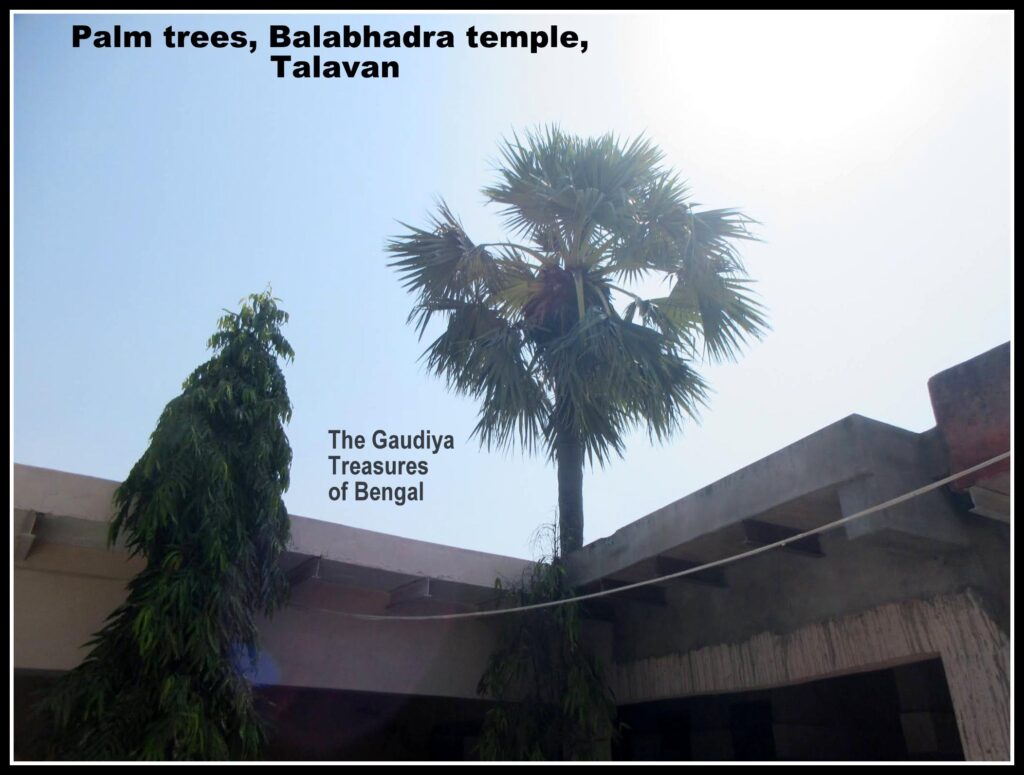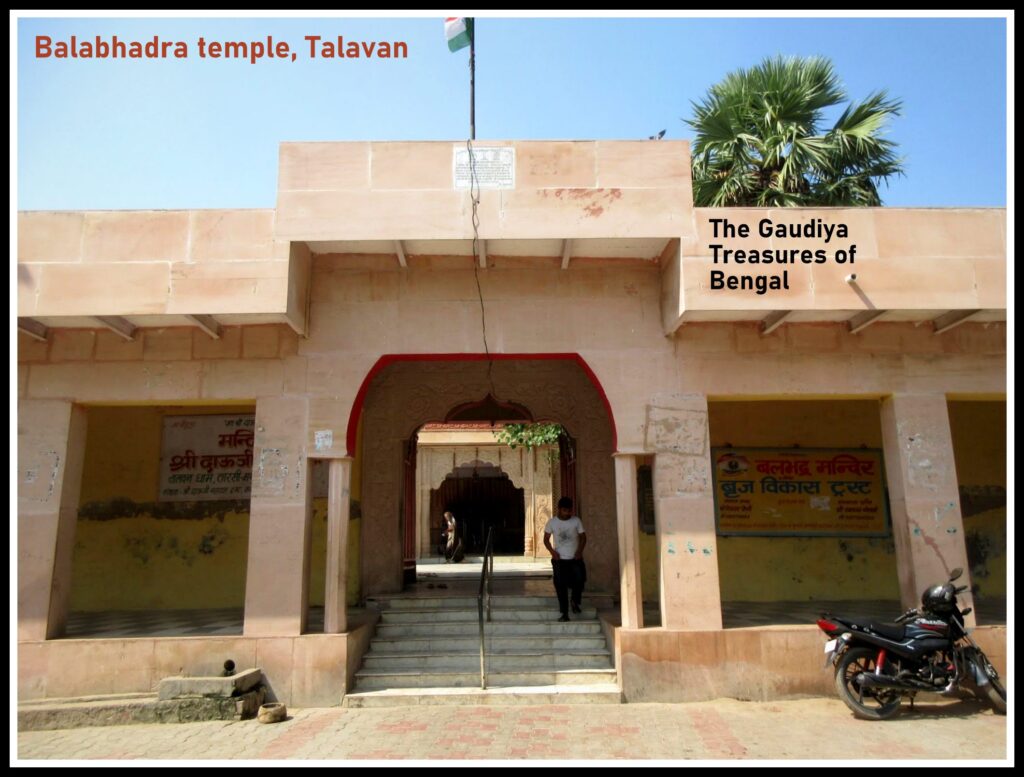
About 5 Kilometers south of Maholi (Madhuvan) and 10 Kilometers south of Mathura, is situated the village of Tarsi, whose ancient name was Talavan. Over here are worshiped beautiful deities of Lord Balarama (Dauji) and Revati devi. Next to the temple lies ‘Balabhadra Kunda’, which is also sometimes referred to as ‘Sankarshana Kunda’. It was over here in the forest of Talavan that Lord Balarama had killed demon Dhenukasura and his ass-demon associates. The place was previously filled with tall ‘Tala’ trees (palm trees) during Dvapara yuga and the region had thus derived its name. Presently Tarsi is not a forest anymore, and only a few Tala trees remain scattered here and there. Some of these Tala trees can be found today within the precincts of the temple compound. Talavan has been widely glorified throughout the Vedic scriptures. Skanda Purana states –
Aho tala vanam punyam yatra talair hato surah
Hitaya yadavanam ca atma kridanakaya ca
–
Ah, the forest of Talavan is highly auspicious. It is here that a demon (Dhenukasura) was killed by being thrown on a Tala tree for the benefit of the yadavas and for the purpose of the Lord’s play.
The forest of Talavan has been described in Sri Hari Vamsa as follows –
sa tu desah samah snigdhah
su mahan Krishna mrittikah
darbha prayah sthuli bhuto
lostra pasana varjitah
–
The land there (in Talavan) is smooth, and very wide. The ground is black, densely covered with darbha grass, and devoid of rocks and stones.
Lord Balarama kills Dhenukasura at Talavan
The forest of Talavan was once guarded by a demon named Dhenukasura who had assumed the form of a jackass. This demon Dhenukasura was a friend of Kansa, Krishna’s maternal uncle. Dhenukasura was known to eat men alive and thus everyone was scared to step into the forest. Once while Krishna and Balarama were resting after their play, Sridama, along with Subala, Stoka Krishna and others informed the two brothers of Dhenukasura. They said that even birds were afraid of flying over the forest. Although the forest was stacked with tall Tala trees and although many of these delicious ripened fruits had fallen off and were lying on the ground, they could not be eaten as they were guarded by the jackass demon and his evil friends. Thus the cowherd boys encouraged the two brothers to go and kill Dhenukasura.

Krishna and Balaram laughed and proceeded toward Talavan. Balarama entered the forest first and with His two strong arms began forcefully shaking the tall palm trees. As a result, the palm fruits began falling onto the ground. When Dhenuka heard this noise, he attacked Balarama. The powerful demon struck upon the Lord’s chest with the hooves of his hind legs. Running about, he prepared to strike the Lord again. Dhenukasura now placed himself with his back towards Lord Balarama. Yelling and seething the demon hurled his two hind legs at Him. Lord Balarama however seized the demon by his hooves, and reeling him about with His one hand, threw him onto the top of a Palm tree. The intense whirling motion killed Dhenukasura.
Unable to bear Dhenukasura’s weight, the tree broke and fell down. This tree knocked other trees and this cascading effect induced them to tumble as well. The other ass demon friends of Dhenukasura assailed Krishna and Balarama. The brothers seized them one by one and tossed them on top of the Tala trees. Soon all the demons were killed. The ground was full of ripened Palm fruits while the slain demons were seen dangling on top of the broken Palm trees. It seemed as if the sky had become bedecked with clouds (demons who were dangling from the top). The demigods showered flowers upon Krishna and Balarama. The people were now able to wander freely within Talavan and savor fruits. The cows could also be taken to pasture in the forest.
Dhenukasura – the incarnation of Sahasika
Garga Samhita describes that in his previous life Dhenukasura was Sahasika, one of the sons of Bali Maharaja (son of Virochana). Once he was enjoying himself with ten thousand women on the Gandhamadana mountain. It so happened that Durvasa muni was meditating in a nearby cave. The sound of the musical instruments and ankle bells broke the sage’s trance.

Sage Durvasa who had grown thin performing austerity, sported a long beard and walked with wooden sandals holding a stick. Fuming with anger, he compared Sahasika to an animal and cursed him to take birth as a jackass. When Sahasika repented for his actions, Durvasa became appeased. The sage then comforted Sahasika informing him that he would become liberated after 400,000 years when Lord Balarama would kill him in the forest of Talavan. Previously Krishna had granted Prahlada Maharaja the boon that his descendants would not be slain by Him. Hence Krishna arranged for Lord Balarama to kill the demon Dhenukasura.
Dhenukasura represents ignorance
Srila Bhaktivinoda Thakura writes in Chaitanya Shiksamrita that devotees must endeavor to cleanse themselves of the anarthas (sins) that Lord Balarama slays. Dhenukasura represents the sin of bad mentality, foolishness, lack of spiritual intuition, and superstition. The demon represents the ignorance of one’s spiritual identity, the identity of harinama (holy names of Krishna), the identity of Krishna, and one’s entanglement in avidya (false knowledge). The aspiring devotee must remove these barriers to pure devotional service (suddha bhakti) by means of their strong endeavors aided by the mercy of Krishna.

Dhenukasura was a jackass who tried to prevent others from relishing the palm fruits that he himself was unable to taste, as they lay on top of the palm trees. So naive people who are unable to comprehend the exalted teachings of Vaishnavism that have been written down by previous acharyas are inclined to energetically prevent others from accessing these works. This is especially the case with devotees having a diminutive judgment. They are mechanically addicted to regulative principles but have no inclination to strive to attain a higher goal. But Vaishnavism holds within itself the prospect of infinite progress. Being confined to narrow scriptural regulations, they ignore the unconventional path of spontaneous love of God (Raga). Hence it is not possible for one to taste the real nectar of divine love unless the bad habits characterized by our materialistic arguments, sectarianism, staying attached to the regulative process without attaching oneself to God, spiritual ignorance, etc are defeated. These sins can however be destroyed by following the spiritual master who kills these demons through his instructions. Lord Balarama, who represents our spiritual master, shakes the trees of our sins, just like he once shook the palm trees of Talavan. The spiritual master appears in our hearts and kills these demoniac tendencies. But as Srila Bhaktivinoda Thakura stresses that this must be accomplished by the determined effort of the devotee in addition to being aided by the Lord’s mercy.
What to See :
- Beautiful deities of Krishna, Balarama and Revati devi who are duly worshiped in the Balabhadra temple.
- Balabhadra Kunda which lies adjacent to the temple.
- Tall Tala (Palm) trees that lie within the temple compounds.
How to Reach :
Tarsi (Talavan) is well connected via roadways and lies about 10 kilometers south of Mathura Railway station. Tarsi falls under the Mathura block and lies within the Mathura district of Uttar Pradesh, India. Having reached Tarsi, one can enquire about the ‘Balabhadra temple’ which is sometimes referred to as the ‘Dauji temple’ locally, to reach the holy site.
Watch video :